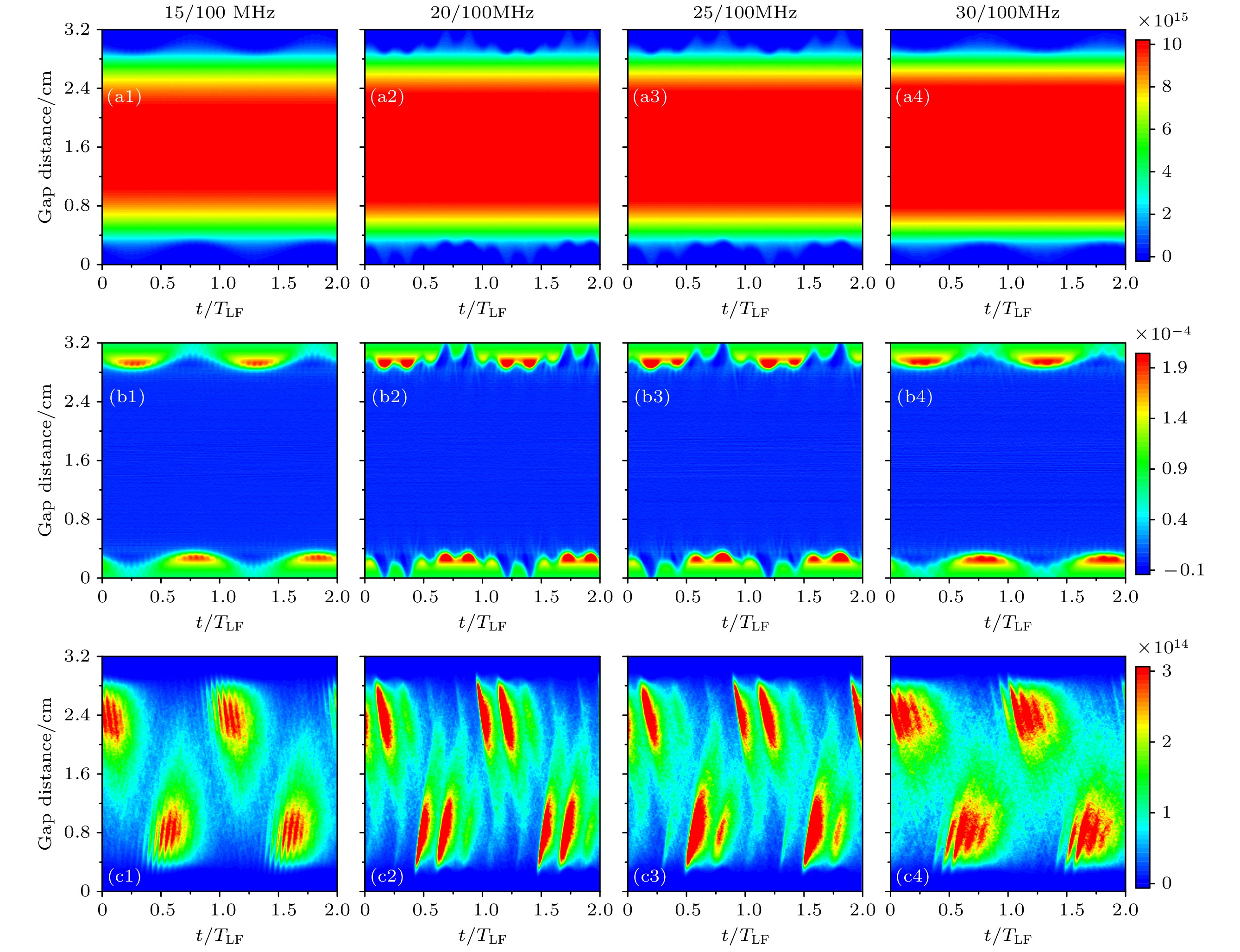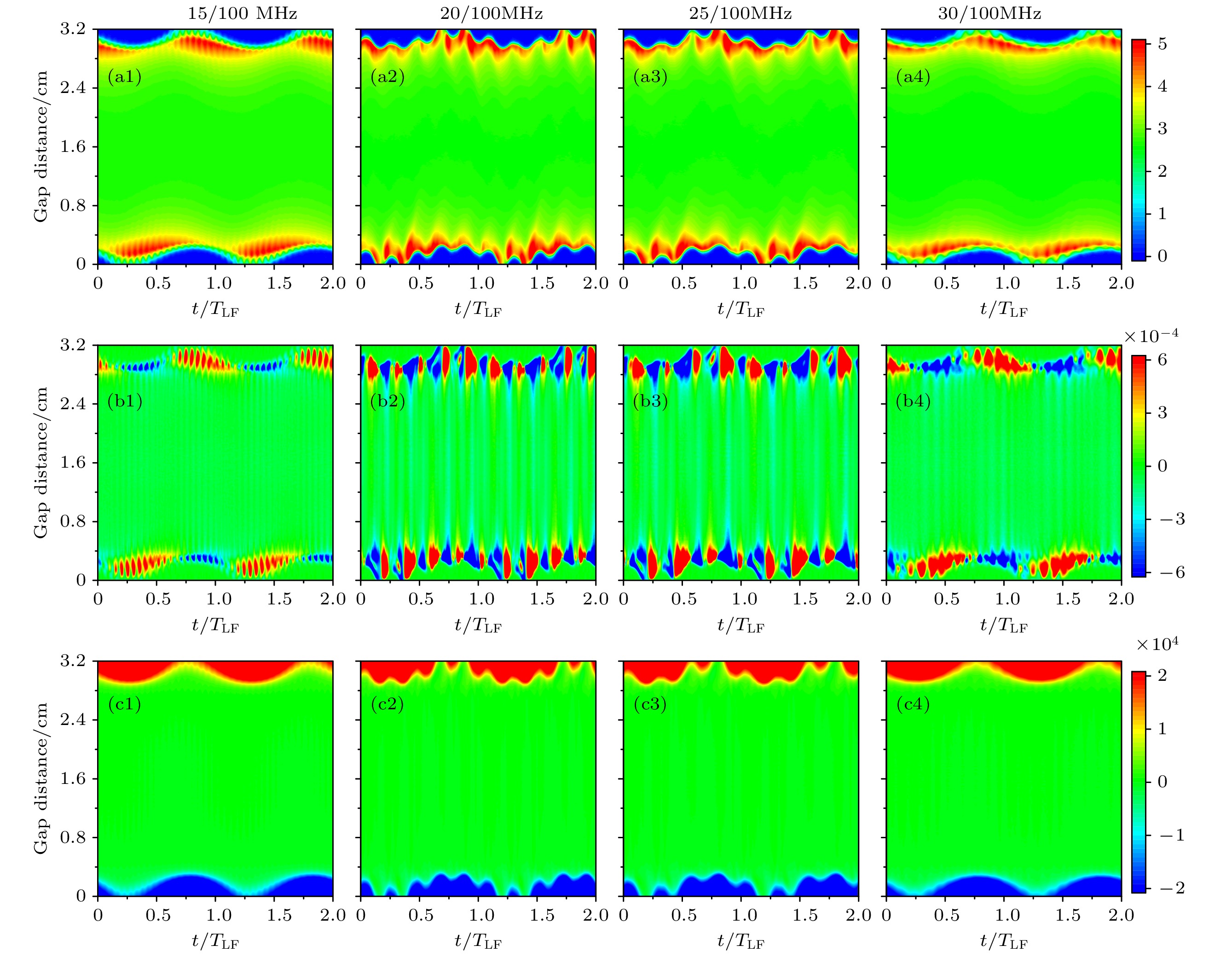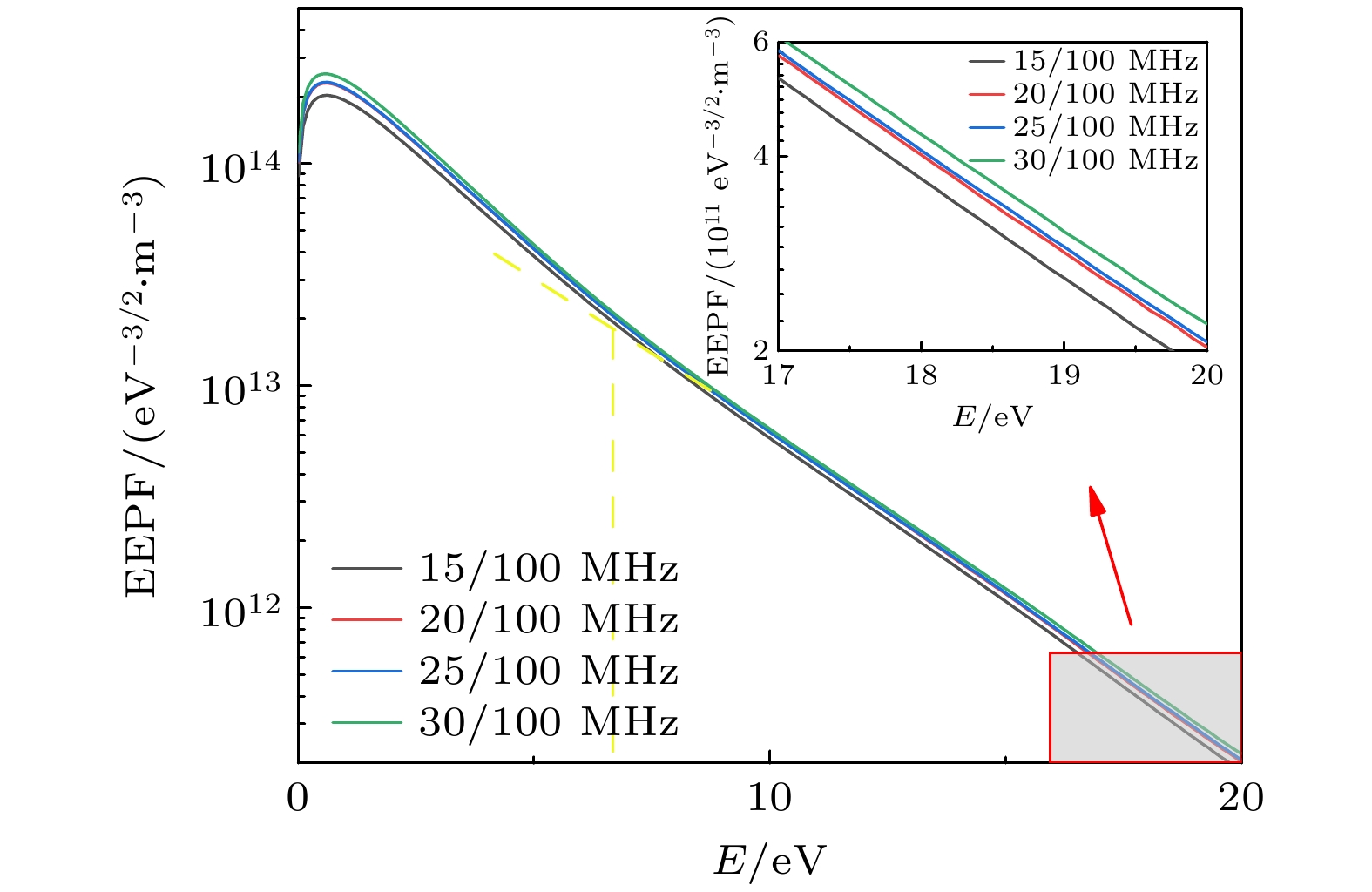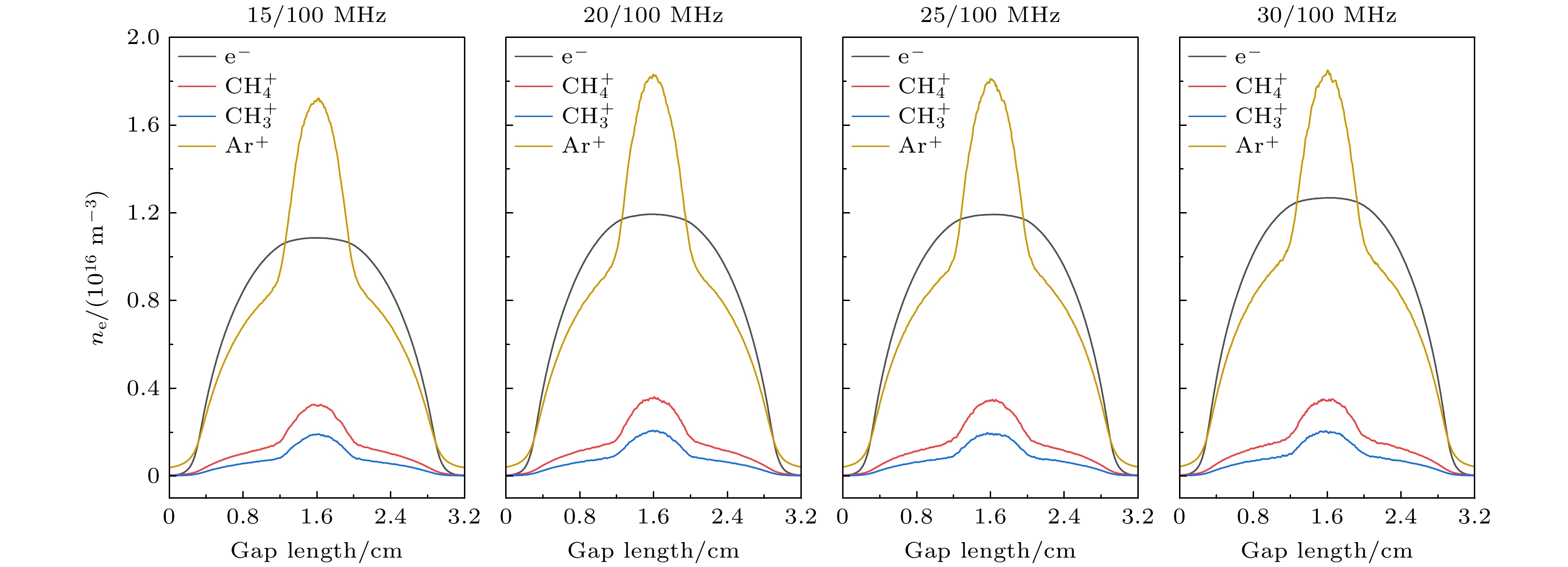-
近年来, 双频容性耦合等离子体放电技术在先进材料加工领域展现出显著优势. 本文通过一维粒子模拟/蒙特卡罗碰撞(PIC/MCC)模拟方法, 引入外加磁场, 研究了在双频(20/100 MHz)双极容性耦合等离子体放电中, 低频频率对双频容性耦合氩/甲烷等离子体放电特性的影响. 模拟结果表明, 在高频频率为低频频率的整数倍时, 高频与低频叠加显著, 鞘层振荡更明显. 随着低频频率的增大, 电子密度、电荷密度、高能电子密度以及电子加热率都随之增大, 其中电子密度随低频频率增大达14%. 鞘层附近的电子温度随低频频率的增大出现下降趋势, 大约下降12%. 电子能量概率分布(EEPF)表现为双麦克斯韦分布, 且当低频频率增大时, 低能电子和高能电子的布居数都增多, 同时讨论了低频频率的增大对各种离子的密度的影响, 以及到达极板处的$ {\text{CH}}_{4}^{+} $, $ {\text{CH}}_{3}^{+} $粒子的角度与能量的变化分布.
-
关键词:
- 容性耦合等离子体放电 /
- Ar/CH4等离子体 /
- 粒子模拟/蒙特卡罗碰撞
In recent years, dual-frequency capacitively coupled plasma discharge technology has demonstrated remarkable advantages in the fields of material processing. In this paper, a one-dimensional PIC/MCC (particle-in-cell/Monte Carlocollision) simulation method is used to discuss the influence of low frequency on the discharge characteristics of capacitively coupled argon/methane plasma driven by dual-frequency (20/100 MHz) dipole, with an external magnetic field added. The simulation results show that when the high frequency is an integer multiple of the low frequency, the superposition of high and low frequencies is significant, and the sheath oscillation is more obvious. As low frequency increases, the electron density, charge density, high-energy electron density and electron heating rate all increase. Specifically, as low frequency increase, the electron density increases to 14%, the electron temperature near the sheath decreases by about 12%, the electron energy probability distribution (EEPF) shows a double Maxwellian distribution, the populations of both low-energy electrons and high-energy electrons increase, and at the same time, the densities of various ions and the angle and energy distributions of ${\text{CH}}_{4}^{+} $ and ${\text{CH}}_{3}^{+} $ particles reaching the electrode plates are influenced. In the Ar/CH4 plasma driven by dual-frequency, with external magnetic field added, the controlling of ion energy can effectively optimize the structure and performance of carbon-containing films. By regulating discharge parameters to control the incident angle of the ions on the substrate, carbon-containing atoms can be deposited in a specific direction, thereby achieving the directional growth of carbon-containing films. This is significant for the preparation of graphene films, carbon nanotube arrays, etc. Meanwhile, the regulation of the incident angle of ions is helpful to improve the binding force between the carbon film and the substrate. It is found in this study that when the incident angle of the ions is around 0.32, the average energy of the ions reaches its peak. This peak is most significant at a low frequency of 15 MHz. The results in this paper provide a theoretical reference for preparing carbon films. [1] Li Y M, Mann D, Rolandi M, Kim W 2004 Nano Lett. 4 317
 Google Scholar
Google Scholar
[2] Donnelly V M, Kornblit A 2013 J. Vac. Sci. Technol. A. 31 050825
 Google Scholar
Google Scholar
[3] Jung C O, Chi K K, Hwang B G, Moon J T, Lee M Y, Lee J G 1999 Thin Solid Films 341 112
 Google Scholar
Google Scholar
[4] Schulze J, Gans T, O'Connell D, Czarnetzki U, Ellingboe A R, Turner M M 2007 J. Phys. D: Appl. Phys. 40 7008
 Google Scholar
Google Scholar
[5] Boyle P C, Ellingboe A R, Turner M M 2004 J. Phys. D: Appl. Phys. 37 697
 Google Scholar
Google Scholar
[6] Robiche J , Boyle P C , Turner M M, Ellingboe A R 2003 J. Phys. D: Appl. Phys. 36 1810
[7] Goto H H, Löwe H D, Ohmi T 1992 J. Vac. Sci. Technol. A. 10 3048
 Google Scholar
Google Scholar
[8] Goto H H, Löwe H D, Ohmi T 1993 IEEE Trans. Semicond. Manuf. 6 58
 Google Scholar
Google Scholar
[9] Tsai W, Mueller G, Lindquist R, Frazier B, Vahedi V 1996 J. Vac. Sci. Technol. B 14 3276
 Google Scholar
Google Scholar
[10] Sharma S, Turner M M 2014 J. Phys. D: Appl. Phys. 47 285201
 Google Scholar
Google Scholar
[11] Kim H C, Lee J K, Shon J W 2003 Phys. Plasmas 10 4545
 Google Scholar
Google Scholar
[12] Yang S, Zhang W, Shen J F, Liu H, Tang C J, Xu Y H, Cheng J, Shao J R, Xiong J, Wang X Q, Liu H F, Huang J, Zhang X, Lan H, Li Y C 2024 AIP Adv. 14 065104
 Google Scholar
Google Scholar
[13] Sharma S, Sirse N, Turner M M, Ellingboe A R 2018 Phys. Plasmas 25 063501
 Google Scholar
Google Scholar
[14] Yin G Q, Gao S S, Liu Z H, Yuan Q H 2022 Phys. Lett. A 426 127910
 Google Scholar
Google Scholar
[15] 高闪闪2022 硕士学位论文(兰州: 西北师范大学)
Gao S S 2022 M. S. Thesis (Lanzhou: Northwest Normal University
[16] Yang S L, Zhang Y, Wang H Y, Cui J W, Jiang W 2017 Plasma Processes Polym. 14 1700087
 Google Scholar
Google Scholar
[17] Yang S L, Chang L, Zhang Y, Jiang W 2018 Plasma Sources Sci. Technol. 27 035008
 Google Scholar
Google Scholar
[18] Yan M H, Wu H H, Wu H, Peng Y L, Yang S L 2024 J. Vac. Sci. Technol. A 42 053007
 Google Scholar
Google Scholar
[19] Sharma S, Patil S, Sengupta S, Sen A, Khrabrov A, Kaganovich I 2022 Phys. Plasmas 29 063501
 Google Scholar
Google Scholar
[20] Sun J Y, Wen H, Zhang Q Z, Schulze J, Liu Y X, Wang Y N 2022 Plasma Sources Sci. Technol. 31 085012
 Google Scholar
Google Scholar
[21] Zheng B C, Wang K L, Grotjohn T, Schuelke T, Fan Q H 2019 Plasma Sources Sci. Technol. 28 09LT03
 Google Scholar
Google Scholar
[22] Yang S L, Zhang Y, Wang H Y, Wang S, Jiang W 2017 Phys. Plasmas 24 033504
 Google Scholar
Google Scholar
[23] Liu Y X, Liang Y S, Wen D Q, Bi Z H, Wang Y N 2015 Plasma Sources Sci. Technol. 24 025013
 Google Scholar
Google Scholar
[24] Yin G Q, Jiang Y B, Yuan Q H 2024 Mod. Phys. Lett. B 38 2450269
[25] Wang J-C, Tian P, Kenney J, Rauf S, Korolov I, Schulze J 2021 Plasma Sources Sci. Technol. 30 075031
 Google Scholar
Google Scholar
[26] Birdsall C K 1991 IEEE Trans. Plasma Sci. 19 65
 Google Scholar
Google Scholar
[27] Vahedi V, Surendra M 1995 Comput. Phys. Commun. 87 179
 Google Scholar
Google Scholar
[28] Verboncoeur J P 2001 J. Comput. Phys. 174 421
 Google Scholar
Google Scholar
[29] 沈向前, 谢泉, 肖清泉, 陈茜, 丰云 2012 物理学报 61 165101
 Google Scholar
Google Scholar
Shen X Q, Xie Q, Xiao Q Q, Chen Q, Feng Y 2012 Acta Phys. Sin. 61 165101
 Google Scholar
Google Scholar
[30] 金晓林, 杨中海 2006 物理学报 55 5930
 Google Scholar
Google Scholar
Jin X L, Yang Z H 2006 Acta Phys. Sin. 55 5930
 Google Scholar
Google Scholar
[31] Song M Y, Yoon J S, Cho H, Itikawa Y, Karwasz G P, Kokoouline V, Nakamura Y, Tennyson J 2015 J. Phys. Chem. Ref. Data. 44 023101
 Google Scholar
Google Scholar
[32] Sun J Y, Zhang Q Z, Liu J R, Song Y H, Wang Y N 2020 Plasma Sources Sci. Technol. 29 114002
 Google Scholar
Google Scholar
-
图 3 固定磁场强度为20 G, Ar∶CH4 = 0.85∶0.15, (a)电子温度 (eV), (b)电子加热率, (c)电场(V/m)随低频频率变化的时空分布图
Fig. 3. Spatiotemporal distribution diagram of the (a) electron temperature (eV); (b) electron heating rate; (c) electric field (V/m) with low frequency at a fixed magnetic field strength of 20 G and Ar∶CH4 = 0.85∶0.15.
图 6 固定磁场强度为20 G, Ar∶CH4 = 0.85∶0.15, 到达极板处的$ {\text{CH}}_{4}^{+} $, $ {\text{CH}}_{3}^{+} $粒子在每个速度方向与轴向的夹角处能量的平均值随低频频率变化的分布图
Fig. 6. Distribution of the average value of the energy of $ {\text{CH}}_{4}^{+} $ and $ {\text{CH}}_{3}^{+} $ particles arriving at the pole plate at the angle between each velocity direction and the axial direction with low frequency at a fixed magnetic field strength of 20 G and Ar∶CH4 = 0.85∶0.15.
表 1 碰撞反应类型
Table 1. Collision reaction type in the simulation.
序号 反应式 碰撞类型 阈值/eV 1 $ {{\text{e}}^{{ - }}}{\text{ + Ar}} \to {{\text{e}}^{{ - }}}{\text{ + Ar}} $ 弹性碰撞 0 2 $ {{\text{e}}^{{ - }}}{\text{ + Ar}} \to {{\text{e}}^{{ - }}}{\text{ + Ar}} $ 激发碰撞 11.5 3 $ {{\text{e}}^{{ - }}}{\text{ + Ar}} \to 2{{\text{e}}^{{ - }}}{\text{ + A}}{{\text{r}}^{+}} $ 电离碰撞 15.80 4 $ {\text{A}}{{\text{r}}^{+}}{\text{ + Ar}} \to {\text{A}}{{\text{r}}^{+}}{\text{ + Ar}} $ 弹性碰撞 0.00 5 $ {\text{A}}{{\text{r}}^{+}}{\text{ + Ar}} \to {\text{Ar + A}}{{\text{r}}^ + } $ 电荷交换 0.00 6 $ {{\text{e}}^{{ - }}}{\text{ + C}}{{\text{H}}_4} \to {{\text{e}}^{{ - }}}{\text{ + C}}{{\text{H}}_4} $ 弹性碰撞 0 7 $ {{\text{e}}^{{ - }}}{\text{ + C}}{{\text{H}}_4} \to {{\text{e}}^{{ - }}}{\text{ + C}}{{\text{H}}_{4}}\left( {{{\text{V}}_{2}}} \right) $ 激发碰撞 0.162 8 $ {{\text{e}}^{{ - }}}{\text{ + C}}{{\text{H}}_4} \to {{\text{e}}^{{ - }}}{\text{ + C}}{{\text{H}}_{4}}\left( {{{\text{V}}_{1}}} \right) $ 激发碰撞 0.362 9 $ {{\text{e}}^{{ - }}}{\text{ + C}}{{\text{H}}_4} \to {{\text{e}}^{{ - }}}{\text{ + C}}{{\text{H}}_{3}}{\text{ + H}} $ 激发碰撞 7.5 10 $ {{\text{e}}^{{ - }}}{\text{ + C}}{{\text{H}}_4} \to {{\text{e}}^{{ - }}}{\text{ + C}}{{\text{H}}_{2}}{+}{{\text{H}}_2} $ 激发碰撞 9.1 11 $ {{\text{e}}^{{ - }}}{\text{ + C}}{{\text{H}}_4} \to {{\text{e}}^{{ - }}}{\text{ + C + 2}}{{\text{H}}_2} $ 激发碰撞 15.5 12 $ {{\text{e}}^{{ - }}}{\text{ + C}}{{\text{H}}_4} \to {{\text{e}}^{{ - }}}{\text{ + CH + }}{{\text{H}}_{2}}{\text{ + H}} $ 激发碰撞 15.5 13 $ {{\text{e}}^{{ - }}}{\text{ + C}}{{\text{H}}_4} \to {2}{{\text{e}}^{{ - }}}{\text{ + CH}}_4^ + $ 电离碰撞 12.63 14 $ {{\text{e}}^{{ - }}}{\text{ + C}}{{\text{H}}_4} \to {2}{{\text{e}}^{{ - }}}{\text{ + H + CH}}_3^ + $ 电离碰撞 12.63 15 $ {{\text{e}}^{{ - }}}{\text{ + C}}{{\text{H}}_4} \to {2}{{\text{e}}^{{ - }}}{+}{{\text{H}}_{2}}{\text{ + CH}}_2^ + $ 电离碰撞 16.2 16 $ {{\text{e}}^{{ - }}}{\text{ + C}}{{\text{H}}_4} \to 2{{\text{e}}^{{ - }}}{\text{ + C}}{{\text{H}}_{3}}{+}{{\text{H}}^ + } $ 电离碰撞 21.1 17 $ {{\text{e}}^{{ - }}}{\text{ + C}}{{\text{H}}_4} \to 2{{\text{e}}^{{ - }}}{\text{ + 2}}{{\text{H}}_{2}}{+}{{\text{C}}^ + } $ 电离碰撞 22 18 $ {{\text{e}}^{{ - }}}{\text{ + C}}{{\text{H}}_4} \to 2{{\text{e}}^{{ - }}}{\text{ + H + }}{{\text{H}}_{2}}{\text{ + C}}{{\text{H}}^ + } $ 电离碰撞 22.2 19 $ {{\text{e}}^{{ - }}}{\text{ + C}}{{\text{H}}_4} \to 2{{\text{e}}^{{ - }}}{\text{ + C}}{{\text{H}}_{2}}{+}{{\text{H}}_2^ +} $ 电离碰撞 22.3 -
[1] Li Y M, Mann D, Rolandi M, Kim W 2004 Nano Lett. 4 317
 Google Scholar
Google Scholar
[2] Donnelly V M, Kornblit A 2013 J. Vac. Sci. Technol. A. 31 050825
 Google Scholar
Google Scholar
[3] Jung C O, Chi K K, Hwang B G, Moon J T, Lee M Y, Lee J G 1999 Thin Solid Films 341 112
 Google Scholar
Google Scholar
[4] Schulze J, Gans T, O'Connell D, Czarnetzki U, Ellingboe A R, Turner M M 2007 J. Phys. D: Appl. Phys. 40 7008
 Google Scholar
Google Scholar
[5] Boyle P C, Ellingboe A R, Turner M M 2004 J. Phys. D: Appl. Phys. 37 697
 Google Scholar
Google Scholar
[6] Robiche J , Boyle P C , Turner M M, Ellingboe A R 2003 J. Phys. D: Appl. Phys. 36 1810
[7] Goto H H, Löwe H D, Ohmi T 1992 J. Vac. Sci. Technol. A. 10 3048
 Google Scholar
Google Scholar
[8] Goto H H, Löwe H D, Ohmi T 1993 IEEE Trans. Semicond. Manuf. 6 58
 Google Scholar
Google Scholar
[9] Tsai W, Mueller G, Lindquist R, Frazier B, Vahedi V 1996 J. Vac. Sci. Technol. B 14 3276
 Google Scholar
Google Scholar
[10] Sharma S, Turner M M 2014 J. Phys. D: Appl. Phys. 47 285201
 Google Scholar
Google Scholar
[11] Kim H C, Lee J K, Shon J W 2003 Phys. Plasmas 10 4545
 Google Scholar
Google Scholar
[12] Yang S, Zhang W, Shen J F, Liu H, Tang C J, Xu Y H, Cheng J, Shao J R, Xiong J, Wang X Q, Liu H F, Huang J, Zhang X, Lan H, Li Y C 2024 AIP Adv. 14 065104
 Google Scholar
Google Scholar
[13] Sharma S, Sirse N, Turner M M, Ellingboe A R 2018 Phys. Plasmas 25 063501
 Google Scholar
Google Scholar
[14] Yin G Q, Gao S S, Liu Z H, Yuan Q H 2022 Phys. Lett. A 426 127910
 Google Scholar
Google Scholar
[15] 高闪闪2022 硕士学位论文(兰州: 西北师范大学)
Gao S S 2022 M. S. Thesis (Lanzhou: Northwest Normal University
[16] Yang S L, Zhang Y, Wang H Y, Cui J W, Jiang W 2017 Plasma Processes Polym. 14 1700087
 Google Scholar
Google Scholar
[17] Yang S L, Chang L, Zhang Y, Jiang W 2018 Plasma Sources Sci. Technol. 27 035008
 Google Scholar
Google Scholar
[18] Yan M H, Wu H H, Wu H, Peng Y L, Yang S L 2024 J. Vac. Sci. Technol. A 42 053007
 Google Scholar
Google Scholar
[19] Sharma S, Patil S, Sengupta S, Sen A, Khrabrov A, Kaganovich I 2022 Phys. Plasmas 29 063501
 Google Scholar
Google Scholar
[20] Sun J Y, Wen H, Zhang Q Z, Schulze J, Liu Y X, Wang Y N 2022 Plasma Sources Sci. Technol. 31 085012
 Google Scholar
Google Scholar
[21] Zheng B C, Wang K L, Grotjohn T, Schuelke T, Fan Q H 2019 Plasma Sources Sci. Technol. 28 09LT03
 Google Scholar
Google Scholar
[22] Yang S L, Zhang Y, Wang H Y, Wang S, Jiang W 2017 Phys. Plasmas 24 033504
 Google Scholar
Google Scholar
[23] Liu Y X, Liang Y S, Wen D Q, Bi Z H, Wang Y N 2015 Plasma Sources Sci. Technol. 24 025013
 Google Scholar
Google Scholar
[24] Yin G Q, Jiang Y B, Yuan Q H 2024 Mod. Phys. Lett. B 38 2450269
[25] Wang J-C, Tian P, Kenney J, Rauf S, Korolov I, Schulze J 2021 Plasma Sources Sci. Technol. 30 075031
 Google Scholar
Google Scholar
[26] Birdsall C K 1991 IEEE Trans. Plasma Sci. 19 65
 Google Scholar
Google Scholar
[27] Vahedi V, Surendra M 1995 Comput. Phys. Commun. 87 179
 Google Scholar
Google Scholar
[28] Verboncoeur J P 2001 J. Comput. Phys. 174 421
 Google Scholar
Google Scholar
[29] 沈向前, 谢泉, 肖清泉, 陈茜, 丰云 2012 物理学报 61 165101
 Google Scholar
Google Scholar
Shen X Q, Xie Q, Xiao Q Q, Chen Q, Feng Y 2012 Acta Phys. Sin. 61 165101
 Google Scholar
Google Scholar
[30] 金晓林, 杨中海 2006 物理学报 55 5930
 Google Scholar
Google Scholar
Jin X L, Yang Z H 2006 Acta Phys. Sin. 55 5930
 Google Scholar
Google Scholar
[31] Song M Y, Yoon J S, Cho H, Itikawa Y, Karwasz G P, Kokoouline V, Nakamura Y, Tennyson J 2015 J. Phys. Chem. Ref. Data. 44 023101
 Google Scholar
Google Scholar
[32] Sun J Y, Zhang Q Z, Liu J R, Song Y H, Wang Y N 2020 Plasma Sources Sci. Technol. 29 114002
 Google Scholar
Google Scholar
计量
- 文章访问数: 1778
- PDF下载量: 59
- 被引次数: 0














 下载:
下载:





